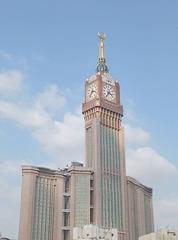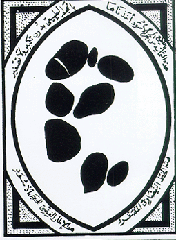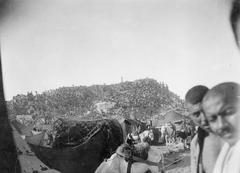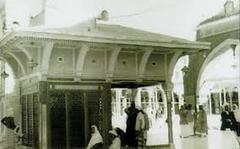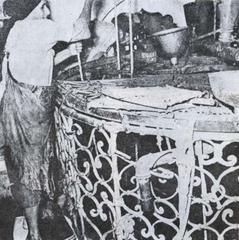Masjid Al-Taneem Visiting Hours, Tickets, and Complete Guide to Mecca Historical Sites
Date: 14/06/2025
Introduction
Masjid Al-Taneem, also known as Masjid Aisha, is one of Mecca’s most significant religious landmarks. Located about 7.5–8 kilometers from the Kaaba, it serves as a pivotal Miqat (station for assuming Ihram) for pilgrims performing Umrah and Hajj, particularly those already within the boundaries of Mecca. Its historical and spiritual importance is deeply intertwined with Islamic tradition, having been the site where Aisha bint Abu Bakr, wife of Prophet Muhammad (PBUH), entered into Ihram during the Farewell Pilgrimage. Today, the mosque is central to the experience of millions of pilgrims and stands as a prime example of Islamic architectural heritage, blending historical elements with modern amenities to serve the needs of all visitors (Saudipedia; Wikipedia; Zamzam Blog).
This guide presents detailed information on Masjid Al-Taneem’s origins, religious significance, visiting hours, facilities, accessibility, travel tips, and nearby historical attractions, ensuring pilgrims and visitors can make the most of their journey to this sacred site.
Table of Contents
- Introduction
- Historical Background and Architecture
- Religious Significance
- Visiting Hours and Entry Information
- Facilities and Accessibility
- Transportation and Directions
- Visitor Etiquette and Ihram Preparation
- Travel Tips and Safety
- Nearby Attractions
- Frequently Asked Questions (FAQs)
- Conclusion and Useful Resources
Historical Background and Architecture
Early Foundations and Evolution
Masjid Al-Taneem is located in the Al-Hil district on the northwestern edge of Mecca, between the mountains Jabal Na’im and Jabal Na’em. Its alternative name, Masjid Aisha, honors Aisha bint Abu Bakr, who was granted special permission by Prophet Muhammad (PBUH) to assume Ihram here—an event that set a precedent for future generations of pilgrims (Zamzam Blog).
Originally established in 834 CE during the Abbasid era, the mosque was built by Abu al-Abbas Abdullah Ibn Mohammed. Over the centuries, it has undergone several renovations, the most extensive of which was completed under King Fahd, transforming it into a modern complex capable of accommodating tens of thousands of worshippers (Saudipedia).
Architectural Features
Unlike the ornate Masjid al-Haram, Masjid Al-Taneem is designed for practicality and comfort. Its contemporary Islamic architecture utilizes white stone and concrete, creating a bright, welcoming space that remains cool in the desert climate. The mosque features:
- Two prominent minarets
- Expansive prayer halls with high-quality carpets
- Large, gender-segregated entrances
- Wide windows for natural light and ventilation
- Shaded outdoor waiting areas and paved walkways
The total complex covers 84,000 square meters, with the mosque itself occupying 6,000 square meters, allowing for efficient crowd management during peak periods (zamzamtravelsbd.com; rehlat.com).
Religious Significance
Role as a Miqat and Boundary of the Haram
Masjid Al-Taneem marks the boundary of the Haram, the sacred precinct of Mecca. While not one of the five main Miqats for those traveling from outside Mecca, it is the closest and most accessible Miqat for residents or those already in Mecca wishing to perform additional Umrahs. Pilgrims must exit the Haram boundary to re-assume Ihram, and Masjid Al-Taneem serves this need efficiently (Wikipedia; Zamzam Blog).
Spiritual Importance and Legal Precedent
The mosque is renowned for its association with Aisha bint Abu Bakr, whose experience established a key jurisprudential ruling: women who become ritually impure during pilgrimage are permitted to renew their Ihram at Taneem. This allowance, rooted in prophetic tradition, remains a critical aspect of Hajj and Umrah rituals for women (Wikipedia). The journey to and from Taneem to assume Ihram is considered an act of devotion, symbolizing renewed spiritual commitment.
Visiting Hours and Entry Information
- Opening Hours: Masjid Al-Taneem operates 24 hours a day, 7 days a week, year-round, including during Ramadan and Hajj (Almomin Travel).
- Entry Fee: There is no admission fee. Entry is free for all Muslim visitors; no tickets or prior booking are required (KSA Journeys).
- Access Restrictions: Like all sacred sites in Mecca, entry is strictly limited to Muslims (Outlook Traveller).
Facilities and Accessibility
Masjid Al-Taneem is equipped with modern amenities to meet the needs of pilgrims:
- Separate Entrances and Changing Rooms: For men and women, ensuring privacy and smooth visitor flow.
- Ablution and Bathing Facilities: Multiple wudu stations, hot and cold showers, and lockers for personal belongings.
- Prayer Halls: Large, air-conditioned spaces with clear separation by gender.
- Wheelchair Accessibility: Ramps, wide doorways, and designated prayer areas for visitors with mobility challenges.
- Restrooms: Clean, well-maintained, and accessible, located near main entrances.
- Shops and Vendors: Ihram garments, unscented toiletries, slippers, and other essentials are available at shops near the mosque (rehlat.com).
Transportation and Directions
How to Reach Masjid Al-Taneem
- By Taxi: The quickest and most convenient option; fares range from 30–50 SAR from Masjid al-Haram, with travel times of 15–20 minutes depending on traffic (KSA Journeys).
- By Bus or Shuttle: Regular services operate during peak periods, especially during Hajj and Ramadan.
- Parking: Ample parking is available but fills up during peak times; early arrival is recommended.
Directions
From Masjid al-Haram, take the Makkah-Madinah road northwest for about 7.5–8 kilometers. Clear signposts guide visitors to the mosque.
Visitor Etiquette and Ihram Preparation
Dress Code
- Men: Two unstitched white cloths (Ihram). No stitched clothing, head covering, or shoes that cover the ankles.
- Women: Modest, loose-fitting attire with a headscarf. No specific color is required, but white is common.
- General: Remove shoes before entering prayer halls and use only unscented toiletries while in Ihram (KSA Journeys; Outlook Traveller).
Conduct
- Maintain silence and reverence inside the mosque.
- Photography is discouraged and may be restricted; always seek permission if unsure.
- Dispose of waste in designated bins; eating and drinking inside prayer halls is prohibited.
- Men and women must use their designated areas for prayer and changing.
Travel Tips and Safety
- Best Times to Visit: Early mornings and late evenings for a quieter experience.
- Personal Belongings: Use provided lockers; keep valuables to a minimum.
- Hydration: Carry water, especially during hot weather.
- Health: Mecca can be extremely hot; sun protection and hydration are essential.
- First Aid: Basic medical facilities are available on-site.
- Security: Surveillance and security personnel ensure visitor safety. Bag checks are routine.
- COVID-19 Measures: Check for current health requirements, such as vaccination proof or mask mandates (Saudi Ministry of Health).
Nearby Attractions
- Masjid Al-Haram: The holiest mosque in Islam, approximately 7 km away, is the focal point of Hajj and Umrah (Almosafer).
- Abraj Al-Bait Towers: Features the world’s tallest clock tower and a luxury hotel complex next to the Grand Mosque (Trip.com).
- Jannat Al Mualla Cemetery: Resting place of several early Islamic figures (Almosafer).
- Mount Arafat: Site of the Prophet’s Farewell Sermon, significant during Hajj (Trip.com).
- Jabal Al-Nour: Home to the Cave of Hira, where the first revelation was received (TravelSetu).
- Makkah Museum: Features exhibits on the history and archaeology of the holy city.
- Masjid Al-Hudaibiyah: Historic site marking the Treaty of Hudaibiyah (Almosafer).
Frequently Asked Questions (FAQs)
Q: What are the mosque’s visiting hours?
A: Open 24 hours daily, year-round.
Q: Is there an entry fee or ticket required?
A: No, entry is free for all Muslim visitors.
Q: How can I get there from Masjid al-Haram?
A: By taxi, bus, or private vehicle via the Makkah-Madinah road.
Q: Are women allowed to visit?
A: Yes, with dedicated prayer and changing areas.
Q: Is the mosque accessible to people with disabilities?
A: Yes, via ramps, wide doorways, and accessible restrooms.
Q: Can non-Muslims visit?
A: No, access to Mecca’s sacred sites is restricted to Muslims only.
Q: Are there shops nearby?
A: Yes, vendors offer Ihram garments, toiletries, and other essentials.
Conclusion and Useful Resources
Masjid Al-Taneem is a cornerstone of the spiritual journey for millions of pilgrims. Its blend of historical reverence, religious importance, and modern convenience makes it an essential destination for anyone performing Umrah or Hajj in Mecca. By understanding the mosque’s role, visitor etiquette, and available facilities, you can ensure a smooth, spiritually fulfilling experience.
Stay up to date with visiting hours, safety protocols, and travel tips by downloading the Audiala app and following official Saudi tourism and health websites. For more in-depth information, consult the resources linked below.
References and Further Reading
- Masjid Al-Taneem Visiting Guide: History, Significance, and Practical Information for Pilgrims and Tourists, 2025, Saudipedia
- Masjid Al-Taneem Wikipedia, 2025
- Zamzam Blog: Masjid Aisha and Its Significance, 2025
- Masjid Al-Taneem (Ayesha Mosque) Facilities, Visiting Hours & Pilgrim Guide in Mecca, 2025, Zamzam Travels BD
- Rehlat Travel: Masjid Taneem Mecca, 2025
- Almomin Travel: Masjid Aisha - The Gateway to Umrah and Hajj, 2025
- KSA Journeys: Masjid Aisha Guide, 2025
- Tourist Authority: What to Know Before Visiting Mecca, 2025
- Outlook Traveller: Guide to Mecca Saudi Arabia, 2025
- Trip.com: Makkah Itinerary and Accommodation
- Almosafer: Historical Places in Makkah
- TravelSetu: Mecca Tourism Guide
- Saudi Ministry of Hajj and Umrah
- Saudi Ministry of Health
